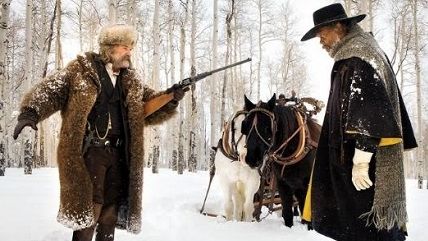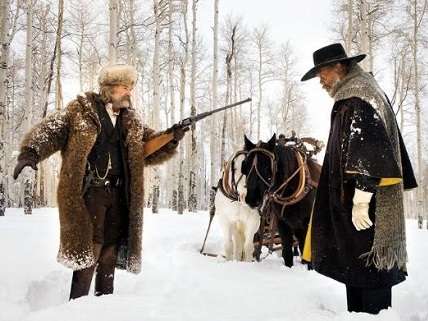Movie Review: The Hateful Eight
Quentin Tarantino's long, slow Western is a surprising misfire.


For its first half, The Hateful Eight seems like Quentin Tarantino's worst movie, talky and formless, even—dare it be said—boring. Then there's a plot flip, and you think: Okay, here we go. But then it goes on seeming like Tarantino's worst movie, collapsing at the end of three bloody hours in a wheeze of exhaustion.
Much has been made of Tarantino's decision to shoot the movie in Ultra Panavision 70, a wide-screen format last employed nearly 50 years ago on a Charlton Heston epic called Khartoum. This nerdish determination required the Weinstein Company to scour the country for surviving 70mm projectors, painstakingly restore them, and train projectionists to operate them for a limited "roadshow" release in a hundred theaters nationwide. (The movie will be re-released in a regular 35mm version on New Year's Day.)
This seems like lot of trouble (and mad expense) to go to for a movie that's largely set in one room. But it does pay off, to an extent, in deeply detailed images; and cinematographer Robert Richardson, shooting his fifth Tarantino film, produces some grand panoramas in the picture's long opening passage, which begins with a stagecoach making its way—very slowly—through a snowy mountain pass in post-Civil War Wyoming.
Inside the stagecoach are a bounty hunter named John Ruth (Kurt Russell) and his prisoner, Daisy Domergue (Jennifer Jason Leigh), whom he's transporting to the town of Red Rock to be hanged. With a blizzard moving in, the stagecoach is flagged down by two more characters. One is Major Marquis Warren (Samuel L. Jackson), a former Union soldier who's now a bounty hunter himself. (This being a Tarantino movie, Daisy greets Warren with the words "Howdy, nigger.") The other new passenger is Chris Mannix (Walton Goggins), a Confederate loyalist who's also on his way to Red Rock, to become the town's new sheriff.
There's a lot of talking as the stagecoach rattles along, not all of it as masterfully crafted as we've come to expect from Tarantino, who seems to have gotten carried away by his reputation in this department. The dialogue is delivered with requisite gusto by Russell (sporting a moustache the size of a stuffed weasel) and the characteristically intense Jackson. But much of the humor, here and throughout the picture, is mined from continual abuse of the trash-talking Daisy: John Ruth smashes an elbow into her face ("That means shut up") and Warren punches her in the head so hard she goes flying half out of the stagecoach door. She's increasingly bloodied, but remains unbowed, and it must be said that Leigh appears to be having a lot of fun with the role.
The gab marathon abates for a bit when the stagecoach pulls in at a trailside outpost called Minnie's Haberdashery (a cute name, but pointless). Waiting inside are four more characters. One, Oswaldo Mobray, says he's on his way to Red Rock to become the town's new hangman. (He's played by Tim Roth, whose giddy diction suggests either a parody of fellow Tarantino regular Christoph Waltz or a tribute to the late Terry-Thomas; maybe both.) The others are murmuring cowboy Joe Gage (Michael Madsen, doing Bruce Willis), a Mexican called Señor Bob (Demian Bichir), and an old Confederate general named Smithers (Bruce Dern), who glowers at Warren and—this being a Tarantino movie—says, "I don't know that nigger, but I know he's a nigger, and that's all I need to know."
Tarantino is once again instructing us about race hatred and systemic injustice. (Jackson has an eloquent moment when he says, "You got no idea what it's like bein' a black man facin' down America.") We get the message, and while he continues giving it to us, we drift into contemplation of the movie's defects—its cluttered cast and sloggy pace, and the atmosphere of airless enclosure that often makes it feel like a filmed stage play.
The rest of the story unfolds in Minnie's main room. (Despite the building's unimposing exterior, it's more spacious than anyone but Sergio Leone might expect.) The characters stand around and talk. They sit around a table eating stew and talking some more. There's a lot of business with a broken door and a letter from Abraham Lincoln, and there's a flashback to a scene of sexual violence that's so misconceived you figure Tarantino must no longer be accepting outside advice. The absence of proprietor Minnie is our first indication that something's not right at this remote location, and when the plot suddenly shifts in a new direction, Tarantino lets the blood begin to gush pretty much as you'd expect.
The movie has been ill-omened from the start. A first draft of Tarantino's script leaked online last year, and just days ago the completed film—ripped from a DVD screener of the sort sent out to Academy voters—popped up on Internet torrent sites. On top of that, there's still PR blowback from the October police-violence protest in which the director took such a vocal part. All of this would be a drag if The Hateful Eight were a work of dazzling style and vision—if it were prime Tarantino. But it's not.


Show Comments (25)